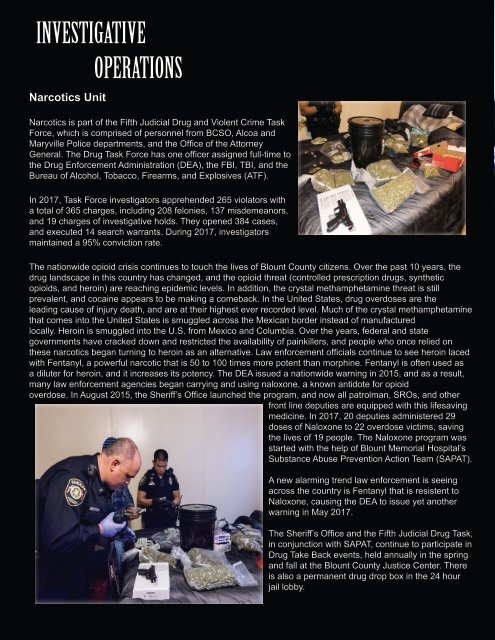2017 Annual Report
You also want an ePaper? Increase the reach of your titles
YUMPU automatically turns print PDFs into web optimized ePapers that Google loves.
INVESTIGATIVE<br />
Narcotics Unit<br />
OPERATIONS<br />
Narcotics is part of the Fifth Judicial Drug and Violent Crime Task<br />
Force, which is comprised of personnel from BCSO, Alcoa and<br />
Maryville Police departments, and the Office of the Attorney<br />
General. The Drug Task Force has one officer assigned full-time to<br />
the Drug Enforcement Administration (DEA), the FBI, TBI, and the<br />
Bureau of Alcohol, Tobacco, Firearms, and Explosives (ATF).<br />
In <strong>2017</strong>, Task Force investigators apprehended 265 violators with<br />
a total of 365 charges, including 208 felonies, 137 misdemeanors,<br />
and 19 charges of investigative holds. They opened 384 cases,<br />
and executed 14 search warrants. During <strong>2017</strong>, investigators<br />
maintained a 95% conviction rate.<br />
The nationwide opioid crisis continues to touch the lives of Blount County citizens. Over the past 10 years, the<br />
drug landscape in this country has changed, and the opioid threat (controlled prescription drugs, synthetic<br />
opioids, and heroin) are reaching epidemic levels. In addition, the crystal methamphetamine threat is still<br />
prevalent, and cocaine appears to be making a comeback. In the United States, drug overdoses are the<br />
leading cause of injury death, and are at their highest ever recorded level. Much of the crystal methamphetamine<br />
that comes into the United States is smuggled across the Mexican border instead of manufactured<br />
locally. Heroin is smuggled into the U.S. from Mexico and Columbia. Over the years, federal and state<br />
governments have cracked down and restricted the availability of painkillers, and people who once relied on<br />
these narcotics began turning to heroin as an alternative. Law enforcement officials continue to see heroin laced<br />
with Fentanyl, a powerful narcotic that is 50 to 100 times more potent than morphine. Fentanyl is often used as<br />
a diluter for heroin, and it increases its potency. The DEA issued a nationwide warning in 2015, and as a result,<br />
many law enforcement agencies began carrying and using naloxone, a known antidote for opioid<br />
overdose. In August 2015, the Sheriff’s Office launched the program, and now all patrolman, SROs, and other<br />
front line deputies are equipped with this lifesaving<br />
medicine. In <strong>2017</strong>, 20 deputies administered 29<br />
doses of Naloxone to 22 overdose victims, saving<br />
the lives of 19 people. The Naloxone program was<br />
started with the help of Blount Memorial Hospital’s<br />
Substance Abuse Prevention Action Team (SAPAT).<br />
A new alarming trend law enforcement is seeing<br />
across the country is Fentanyl that is resistent to<br />
Naloxone, causing the DEA to issue yet another<br />
warning in May <strong>2017</strong>.<br />
The Sheriff’s Office and the Fifth Judicial Drug Task,<br />
in conjunction with SAPAT, continue to participate in<br />
Drug Take Back events, held annually in the spring<br />
and fall at the Blount County Justice Center. There<br />
is also a permanent drug drop box in the 24 hour<br />
jail lobby.<br />
18





